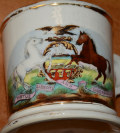site search
online catalog
PENNSYLVANIA STATE COAT OF ARMS CERAMIC SHAVING MUG, POSSIBLY G.A.R.

$225.00
Quantity Available: 1
Item Code: 1202-187
Shipping: Determined by Method & Location of buyer
To Order:
Call 717-334-0347,
Fax 717-334-5016, or E-mail
A nice example of a decorated shaving mug from the 1800s to early 1900s. This one is decorated with gold bands around top and bottom and along the finger loop, and with a full color representation of the Pennsylvania coat of arms on one side. The other has a two-piece wreath, tied with ribbons at the bottom. The center of the wreath was certainly intended to be filled in, and our best guess is that it may have been for the number of a post in the Pennsylvania Department of the G.A.R., the largest organization of Union veterans and political powerhouse in the late 1800s. Had it been simply for a member of the national organization in the state we would expect “G.A.R.” would have been included, but the typical G.A.R. veteran’s cap might carry a “G.A.R.” badge or the post number in a wreath. Stands 4" in height, and measures 4" in diameter at the base.
The condition is very good, with no chips or cracks, strong colors to the coat of arms, and just some slight rubbing to the gold bands, but not the seal, from use and some stains along the bottom rim. This would be a nice addition to a collection of G.A.R. memorabilia. [sr][ph:L]
~~~~~~~~~~~~~~~~~~~~~~~~~~~~~~~~~~~
THIS ITEM, AS WITH ALL OTHER ITEMS AVAILABLE ON OUR WEB SITE,
MAY BE PURCHASED THROUGH OUR LAYAWAY PROGRAM.
CLICK HERE FOR OUR POLICIES AND TERMS.
THANK YOU!
Inquire About PENNSYLVANIA STATE COAT OF ARMS CERAMIC SHAVING MUG, POSSIBLY G.A.R.
For inquiries, please email us at [email protected]
Most Popular
Historical Firearms Stolen From The National Civil War Museum In Harrisburg, Pa »
Theft From Gravesite Of Gen. John Reynolds »
Selection Of Unframed Prints By Don Troiani »
Fine Condition Brass Infantry Bugle Insignia »
British Imported, Confederate Used Bayonet »
Scarce New Model 1865 Sharps Still In Percussion Near Factory New »
featured item
IDENTIFIED ISSUE RED BLANKET OF THEODORE P. BOWKER 13th MASSACHUSETTS - DIED OF WOUNDS AT ANTIETAM!
This is a rare, early-war, identified Massachusetts issue red blanket carried by a soldier in the 13th Massachusetts who was wounded at Antietam on Sept. 17, 1862, and died of those wounds at a U.S. hospital at Rappahannock Station on November 12.… (490-7138). Learn More »
site search
Upcoming Events
May 16 - 18: N-SSA Spring Nationals, Fort Shenandoah, Winchester, VA Learn More »






